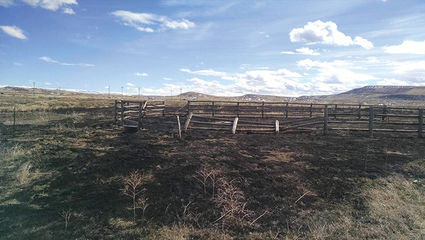Looks can be deceiving: Last year's high grasses can easily become this year's wildfire
WORLAND – Winter appears to have finally given up its battle for supremacy and graciously admitted defeat to spring, much to the delight of man and beast. But as the weather warms and the snow disappears, many spring projects are unearthed.
March 21, 2018

Tracie Mitchell
What was supposed to be a small controlled fire rapidly spread in all directions with about two foot high cheatgrass as fuel. The fire consumed 5.6 acres and a corral before being extinguished by the landowner and the Ten Sleep Fire Department Monday afternoon just outside of Ten Sleep.
WORLAND – Winter appears to have finally given up its battle for supremacy and graciously admitted defeat to spring, much to the delight of man and beast. But as the weather warms and the snow disappears, many spring projects are unearthed.
One spring project for many is getting rid of the dead grasses, leaves and debris from the year before, usually by fire, which can be dangerous if the proper precautions are not followed.
Worland Fire Department Chief Chris Kocher stated that the bumper crop of cheatgrass and other debris from last year, which many people are trying to clean up in the spring, can burn rapidly even though there may still be small patches of snow, saturated ground and muddy conditions. He explained that grasses such as cheatgrass are considered one-hour fuels, which means that it only takes about an hour for it to cure and be ready to burn.
"Most all the fuels in this area are in a dormant phase currently, so they have little to no moisture in them and therefore they will burn very well. After we get a little sunlight during the day on it and if we have a little bit of wind with it, we can very easily see a quickly moving fire," Kocher said. "It's fairly common for people to perceive that, we've had snow up until a week ago in a lot of areas, that stuff won't burn, but because of the fact that it's in a dormant phase and cheatgrass is a one-hour fuel it is very receptive to fire. Until we get a little greening up in April and May these fuels are extraordinary susceptible," he added.
Kocher went on to explain that people need to follow the Washakie County Burning Regulations at all times of the year. According to the Washakie County Burning Regulations:
- Notify Washakie County dispatch center at 347-2242 before you burn. "The biggest thing; when someone is getting ready to burn, they need to call dispatch and let them know who it is doing the burning so dispatch has the ability to contact them back if they need to. The location and access to the controlled burn, the nature of the burn (pile, ditch, open area natural field), name and contact information," Kocher said.
He added, "One of the biggest things that we find is when there is an emergency like that sometimes people get tunnel vision. That's one of the biggest reasons for No. 1 because we don't always think, there have been people call 911 and said this is so and so I have a fire and it's out of control and they hang up. Sometimes in an emergency, all hell is breaking loose and they don't have time or they don't necessarily think about that. If it's [controlled burn] going outside of where it's supposed to be going and it's threatening areas we don't want people putting themselves in the middle of that, the sooner they can call 911 and get adequate resources rolling the sooner we have the ability to control it and keep it to a smaller size. A little bit of pre-planning helps make things go a lot smoother."
- Time of ignition for burning 6 a.m. – 5 p.m. Kocher explained that the cut off time is 5 p.m. because that is usually the end of the burn window. Burn window meaning when the fuels being burned are consumed the best. "As the relative humidity or the RH rises and our temperature starts to drop a little bit then we start to lose our burn window. Soon after that, we start to look at the potential for an inversion which is what everybody gets upset about. With the raise in RH it [fuel] doesn't burn as well so you get more smoke without complete consumption and then when that inversion comes in it starts to hold the smoke down within the community," Kocher explained.
- No fire shall be started if the wind is currently or expected to exceed 15 miles per hour during the burn. "You have to check the weather. In this day and age it is very easy to get access to weather information, whether internet or phone; a variety of different ways to do that. Certainly the wind needs to be blowing away from populated areas when the burning begins. We totally understand that we do get unexpected wind shifts occasionally. But if you're looking at the weather and it says that it's going to blow into the community all day, you probably ought to look at another day to burn," Kocher said.
- The responsible party shall be on site of the controlled burn, during all periods of active fire and at all times have a way to manage the controlled burn to help prevent an out of control wildland fire.
Kocher stated that there are two fire seasons; the usual fire season from late July through the fall and pre-green up season. He also stated, "I'm certainly not telling people not to burn but they need to be very aware and have proper resources to be able to burn safely."
